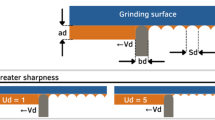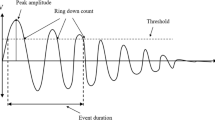Abstract
During the unit event of material interaction in grinding, three phenomena are involved, namely, rubbing, ploughing and cutting, where ploughing and rubbing essentially mean the energy is being applied less efficiently in terms of material removal. Such phenomenon usually occurs before or after cutting. Based on this distinction, it is important to identify the effects of these different phenomena experienced during grinding. Acoustic emission (AE) of the material grit interaction is considered as the most sensitive monitoring process to investigate such miniscule material interactions. For this reason, two AE sensors were used to pick up energy signatures (one verifying the other) correlated to material measurements of the horizontal scratch groove profiles. Such material measurements would display both the material plastic deformation and material removal mechanisms. Previous work has only partially displayed the link in terms of micro and macro phenomena (unit event to normal MG events). In the work presented here, the micro unit grit event will be linked to the macro phenomena such as normal grinding conditions extended to aggressive conditions—burn. This is significant to any safety critical manufacturing environment due to the fact that burn provides surfaces that cannot be accepted when scrutinised under quality considerations and therefore plays an integral part into abrasive machining process. This paper also looks at transparent classification (CART) to give regression capabilities in displaying the micro to macro phenomena in terms of signal intensities and frequency representation. The demarcation between each of the phenomena was identified from acoustic emission signals being converted to the frequency–time domains using short-time Fourier transforms.
Similar content being viewed by others
References
Royer D, Dieulesaint E (2000) Elastic waves in solids I, II. Springer-Verlag Berlin Heidelberg, New York
Griffin J, Chen X (2009) Multiple classification of the acoustic emission signals extracted during burn and chatter anomalies using genetic programming. Int J Adv Manuf Technol 45(11–12):1152–1168
Griffin J (2014) Traceability of acoustic emission measurements for a proposed calibration method—classification of characteristics and identification using signal analysis. Mech Syst Signal Process
Chen X, Griffin J, Liu Q (2007) Mechanical and thermal behaviours of grinding acoustic emission. Int J Manuf Technol Manag (IJMTM) 12(1–3):184–199
Coman R, Marinescu ID (1999) Acoustic emission signal—an effective tool for monitoring the grinding process. Abrasives Dec/Jan. 5
Webster J, Marinescu I, Bennett R (1994) Acoustic emission for process control and monitoring of surface integrity during grinding. Ann CIRP 43(1):299–304
Chen M, Xue BY (1999) Study on acoustic emission in the grinding process automation. American Society of Mechanical Engineers, Manufacturing Engineering Division, MED Manufacturing Science and Engineering—1999 (The ASME International Mechanical Engineering Congress and Exhibition), Nov 14–Nov 19 1999, Nashville, TN, USA, ASME, Fairfield, NJ, USA
Aguiar PR, Willet P, Webster J (1999) Acoustic emission applied to detect workpiece burn during grinding. In: Vahaviolos SJ (ed) Acoustic emission: standards and technology update. ASTM STP 1353. American Society for Testing and Materials, West Conshohocken, Pennsylvania, pp 107–124
Subhash G, Loukus JE, Pandit SM (2001) Application of data dependent systems approach for evaluation of fracture modes during single-grit scratching. Mech Mater 34:25–42
Wang H, Subhash G (2002) An approximate upper bound approach for single-grit rotating scratch with a conical tool on pure metal. Wear 252:911–933
Liu Q, Chen X, Gindy N (2005) Fuzzy pattern recognition of AE signals for grinding burn. Int J Mach Tools Manuf 45(7–8):811–818
Aircraft Accident Report—United Airlines Flight 232, McDonnell Douglas DC-10, Sioux Gateway Airport, Sioux City, Iowa, July 19, 1989, Report Number: NTSB/AAR-90106, 1990
Tonshoff HK, Friemuth KT (2002) Process monitoring in grinding. CIRP Ann—Manuf Technol 51(2):551–571
Chen X, Rowe WB et al (2000) Analysis of the transitional temperature for tensile residual stress in grinding. J Mater Process Technol 107(1–3):216–221
Chen X, Q Liu (2004) Grinding burn identification through AE monitoring. 3rd International Conference and Exhibition on Design and Manufacturing of Die and Moulds, ISAAT
Ren Q, Balazinski M, Jemielniak K, Baron L, Achiche S (2013) Experimental and fuzzy modelling analysis on dynamic cutting force in micro milling. Soft Comput 17:1687–1697
Ren Q, Balazinski M, Baron L (2012) Fuzzy identification of cutting acoustic emission with extended subtractive cluster analysis. Nonlinear Dyn 67(4):2599–2608
Boczar T, Lorenc M (2006) Time–frequency analysis of the calibrating signal generated in the Hsu–Nielsen system. Phys Chem Solid State 7(3):585–588
Hatano H, Chaya T, Watanabe S, Jinbo K (1998) Reciprocity calibration of impulse responses of acoustic emission transducers. IEEE Trans Ultrason Ferroelectronics Freq Control 45(5):1221–1228
Godin N, Huguet S, Gaertner R, Salmon L (2004) Clustering of acoustic emission signals collected during tensile tests on unidirectional glass/polyester composite using supervised and unsupervised classifiers. NDT&E Int 37:253–264
Lawrence RL, Wright A (2001) Rule-based classification systems using classification and regression tree (CART) analysis. Am Soc Photogramm Eng Remote Sens 1137–1142
Kalpakjian S, Schmid SR (2003) Manufacturing process for engineering materials. Prentice Hall, ISBN 0-13-040871-9, pp 510–520
Griffin J, Chen X (2014) Real-time fuzzy-clustering classification of the characteristics of emitted acoustic emission during horizontal single grit scratch tests. Int J Adv Manuf Technol
Opoz T, Chen X (2012) Experimental investigation of material removal mechanism in single grit grinding. Int J Mach Tools Manuf 63:32–40
Coppersmith D, Hong SJ, Hosking JRM (1999) Partitioning nominal attributes in decision trees. Data Min Knowl Disc 3:197–217
Author information
Authors and Affiliations
Corresponding author
Rights and permissions
About this article
Cite this article
Griffin, J.M. Traceability of acoustic emission measurements for micro and macro grinding phenomena—characteristics and identification through classification of micro mechanics with regression to burn using signal analysis. Int J Adv Manuf Technol 81, 1463–1474 (2015). https://doi.org/10.1007/s00170-015-7210-3
Received:
Accepted:
Published:
Issue Date:
DOI: https://doi.org/10.1007/s00170-015-7210-3




